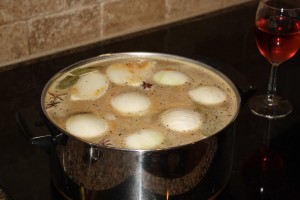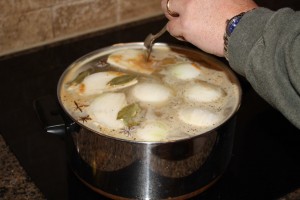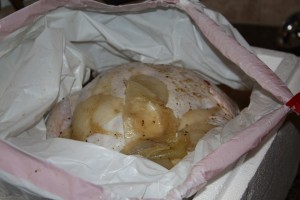It’s almost Turkey Day and I’ve — okay, my whole family has — been having fun with the word “brine.”
It rhymes with lots of great things. Case in point . . .
“It’s time to brine so get me some wine and everything’ll be fine.”
That may or may not have actually been uttered last night during the brining process.
The word “brine” also can replace other words and instantly leave an air of mystery. A la . . .
“If you don’t stop all that ruckus I’m going to brine your behind.”
What does that mean? I’m not really sure, but it gets the job done.
We also like to use the word with a thick Southern drawl . . .
“Brine me that spatula, son.”
So, getting down to business, what exactly is brining? In short, it’s soaking meat in a salt solution — like marinating. In this case, the meat is a turkey and the mixture includes more than salt and water. And it helps the turkey to cook up really moist and flavorful.
You can read more about brining here.
So naturally, the “brine” is the mixture you soak the meat in. And here is the recipe for ours (it’s been passed around from friend to friend to friend for a few years but we understand that it came from Bon Appetit in November 1997.)
Turkey Brine
6 quarts water
2 large onions, quartered
1 cup coarse salt
1 cup choppped fresh ginger
3/4 cup (packed) golden brown sugar
4 large bay leaves
4 whole star anise
12 whole black peppercorns, crushedCombine ingredients in a very large pot. Bring mixture to a simmer, stirring until salt and sugar dissolve. Cool brine completely.
Rinse turkey inside and out. Place turkey in brine, pressing to submerge. Chill overnight, turning turkey twice.
Remove turkey from brine, discard brine. Pat turkey dry with paper towels. Place orange wedges in main cavity. Mix olive oil and sesame oil in a small bowl. Brush over turkey.
Arrange breast side upon grill, centering above empty pan. Cover, cook until internal temperature registers 160 degrees F, about 3 hours depending on the size of your turkey.
Here’s my husband doing the Vanna White thing with our brine. Kind of looks like a witches’ brew.
You notice the bay leaves and onions first. But see those brown things on the left that look like starfish? Those are the whole star anise. They smell like licorice — and with good reason. A chemical compound called anethol makes it smell and taste like licorice.
Now, rest assured, your turkey will not taste like licorice. It’s just a spicy flavor that helps give the brine a great taste.
So, we made up the brine and let it cool Tuesday night of Thanksgiving week. At the end of the evening when it was perfectly cool we rinsed off our turkey and lined a styrofoam cooler with a trash bag. Classy, eh?
We submerged the turkey, twisted the bag shut and put the cooler’s lid on. Then, we slipped that cooler into the refrigerator to let it work its magic over the next day.
We will turn it twice to make sure the entire turkey gets its fair share of briny goodness.
Then, we’ll cook it up Thanksgiving morning according to the recipe above.
We’ve done this on Thanksgiving AND Christmas for the past 3 years and we love the way the turkey turns out. We’ve never had it this moist and tasty before.
I’ll post photos of the final product here after Thanksgiving.
Until then, I’ll be brining for you . . .
(See what I did there? “Brining” instead of “pining?” Aww, forget it.)




